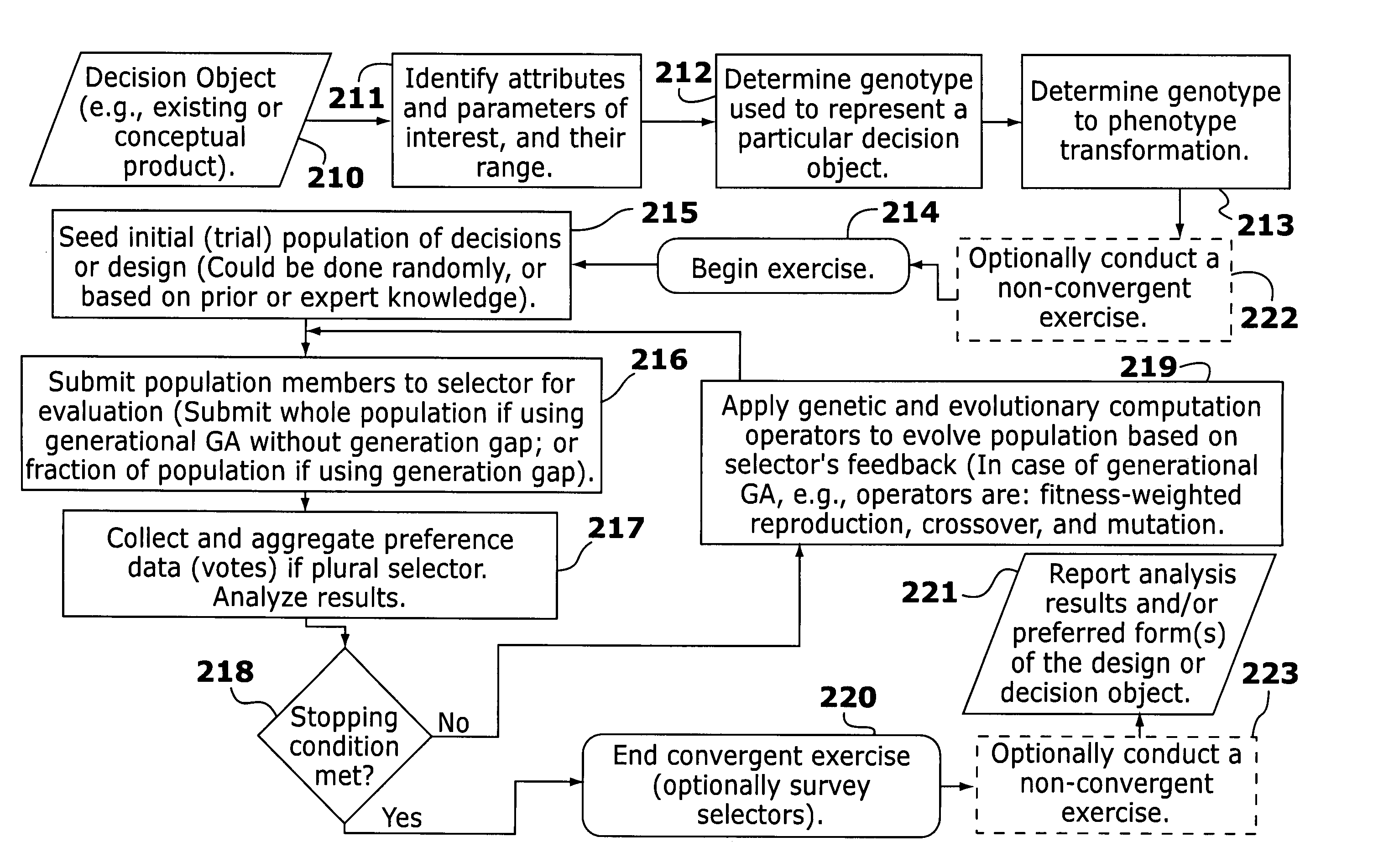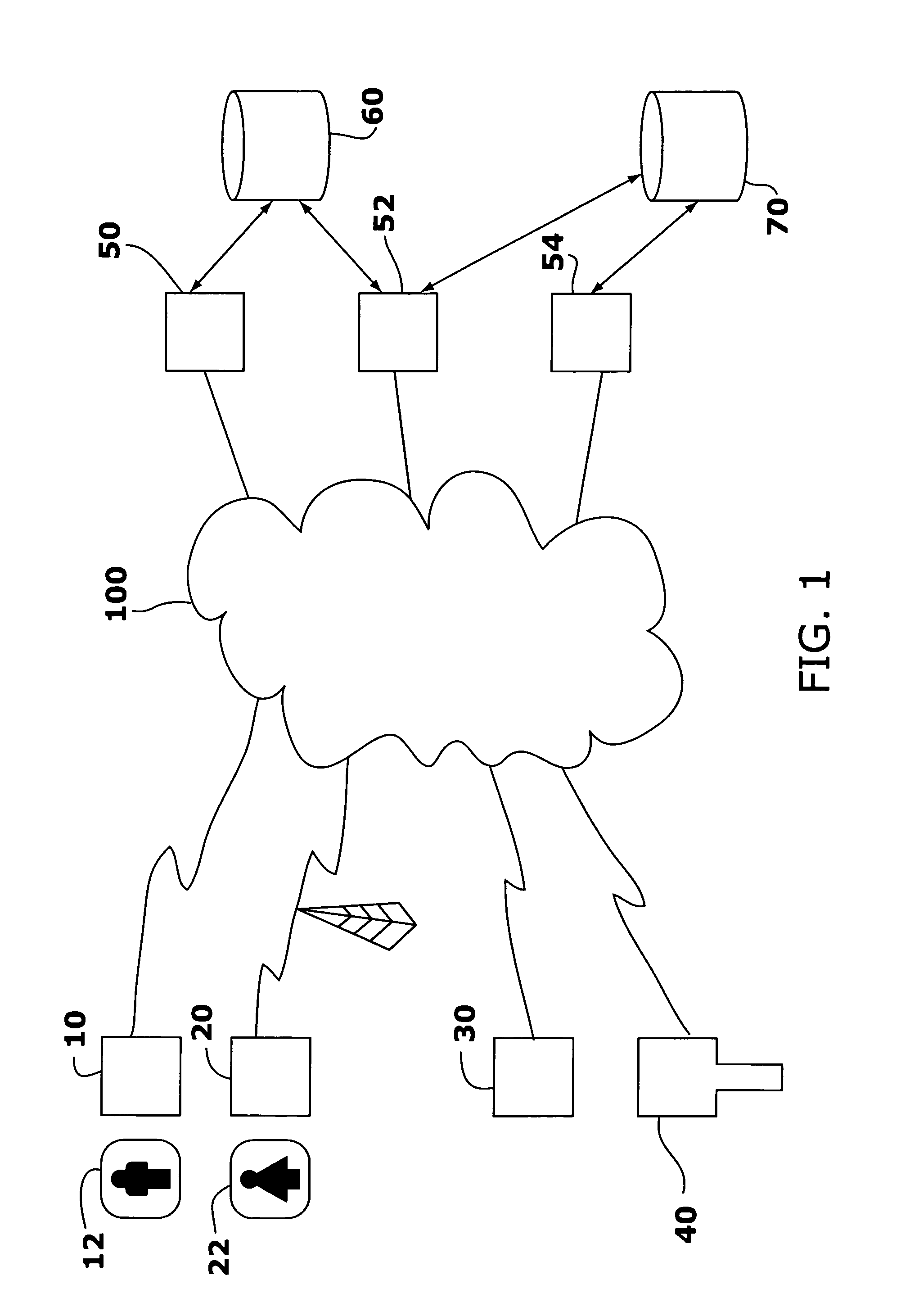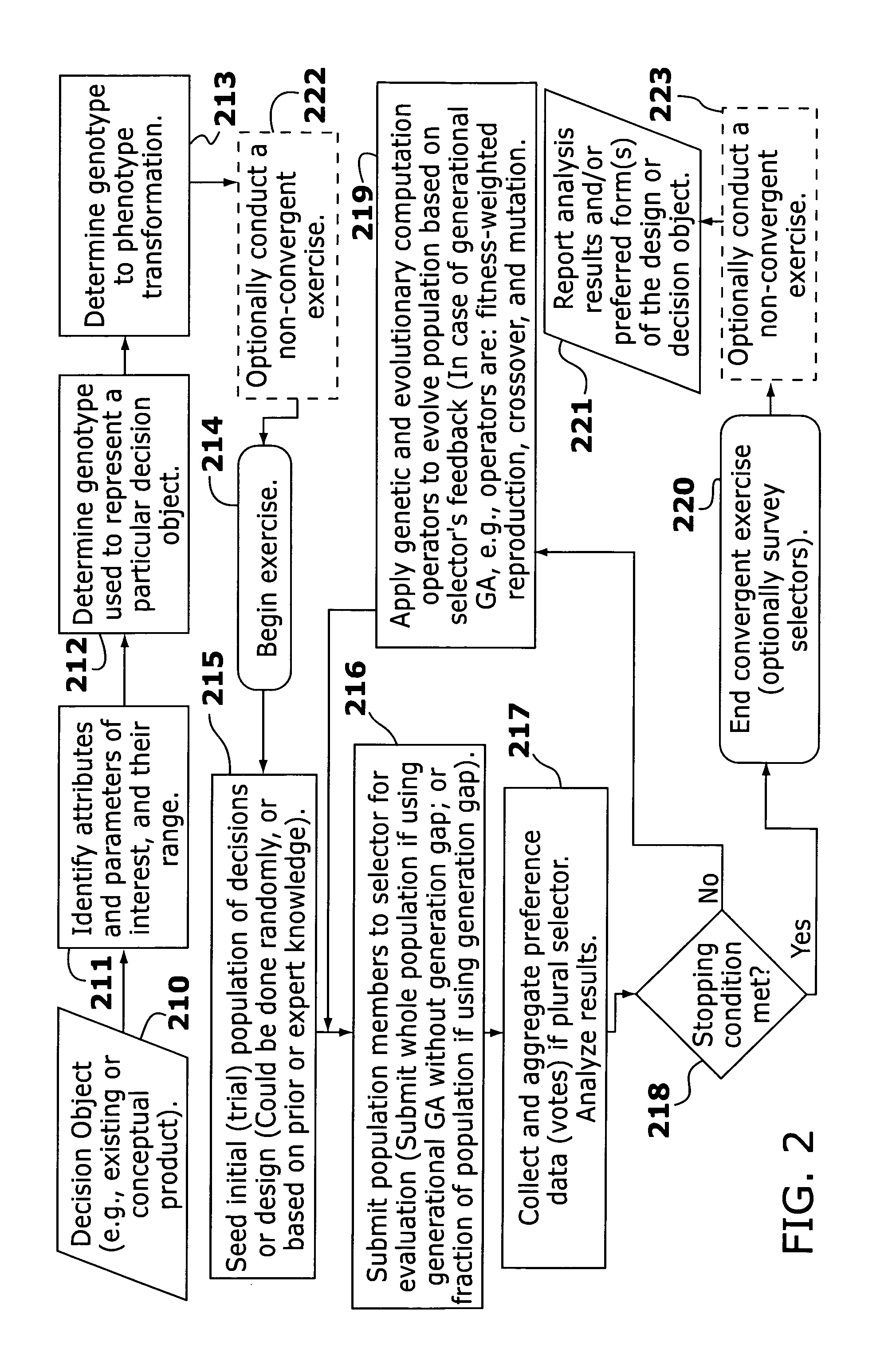[0022] The invention provides methods of efficiently analyzing the design preference tendencies from among various design alternatives for a product or service (referred to herein as a “decision object”) of a group, e.g., a group of consumers. The methods may be used to gather rich data sets informative of the preferences of any given target group, to discern which attributes of a product or service are important or unimportant to the group, and to reveal product forms which respond to the “
voice of the customer” faithfully and without bias. The methods are implemented electronically and typically asynchronously over a relatively short time period. They may be designed to meet any set of design or market research objectives, and to obtain data relevant to any specific design issues considered relevant to any type of product. Participants are easier to recruit than focus groups as they are presented with a relatively large time window into which to fit their engagement, and can work from any convenient location provided they are provided with a link to the network and a means of viewing or otherwise sensing the
design objects and of
logging their preferences.
[0030] In the methods of the invention, proposed designs are presented to the participants, and feedback from the latter is collected via, for example, individual personal computers connected in a network such as an
intranet, an
extranet, or
the internet. It is accordingly possible to control the interpersonal dynamics among the participants. It is also possible to isolate them completely from one another, so that no one of them is aware of the preferences expressed by the others. It is also possible to allow selective levels of information to be shared among the participants, to initiate a real or virtual group discussion, to control the degree of social pressure they may feel, to satisfy a craving for information about the status or direction of the project, or for information about what products others have purchased. This could be used to mimic the network externalities that take place
in real life, where some people tend to favor the same products that their peers are buying and consuming, while others may choose to take a
contrarian attitude. This is important in such products as fashion apparel or accessories, investment instruments or portfolios,
computer software, and so on. Furthermore, by connecting participants via a
computer network, it is possible to assemble a group of participants that are located in very different geographical locales, and to permit asynchronous participation. The methods thus also facilitate
time management, as they reduce the need to bring together all participants at the same time by seamlessly integrating data that is received at different points in time (in certain embodiments of the invention).
[0034] Broadly, the invention involves generating and presenting, typically electronically, a number of design alternatives to persons who are participating in the design, selection, or market research exercise. The participants (selectors) transmit data indicative of their preferences among or between the presented design alternatives, and that data is used to derive or select a new generation of design alternatives or proposals, as a basis for a conjoint analysis to determine attribute preference information, or both. In a given exercise, decision objects specifically designed or selected to enhance a conjoint analysis (or random decision objects) are presented to a selector. These decision objects may be presented first, or at any time, and that data is used to perform a conjoint analysis, either
on the fly as the exercise continues, or after termination of data collection. In one embodiment, an
iterative design exercise is conducted as disclosed in co-pending U.S. application Ser. No. 10 / 053,353, wherein expressed
preference data is used to drive the selection of subsequently presented decision objects or to evolve in real time new decision objects to be presented in subsequent iterations. In this embodiment, the preference information also is used to conduct a conjoint exercise. This permits group preference determination not only of overall designs, but also of the attributes driving the design preferences. In a preferred embodiment, data from early-presented decision objects provide the basis of a conjoint analysis. The results of the conjoint analysis are then used to populate, or determine attribute levels or combinations of attributes for decision objects used in a subsequent, typically seamless,
iterative design exercise. In still another embodiment, interspersed in the respective presentations, are displays designed to facilitate conjoint analysis. In this embodiment, the displays may have been driven by earlier
preference data. A conjoint analysis may be done at any time after sufficient
objective data is collected, e.g., while the exercise is in progress or after its data collection phase terminates. This permits development of rich market information predictive of consumer behavior.
[0040] The method may involve iterating the cycle of selection and derived product
form generation a sufficient number of times to permit determination of one or a plurality of product forms preferred by the selector. Particularly in a group design effort where the selector is a group of consumers, this may lead to the identification of more than one preferred design. Collecting
demographic data about the selector and correlating the product forms preferred by the selector to the
demographic data permits identification of market segments which may be exploited using differing strategies. Accordingly, the invention facilitates a new form of market research, in which its proprietor is enabled to discern the relative affinity of a consumer or group of consumers for a given product form, or to discern market segments, for example, early adapters, late majority, etc, and to determine attribute preference information.
[0045] These various computational techniques are not per se considered an aspect of the invention, except insofar as they are used in combination with other process steps as set forth herein or as may be set forth in some of the appended claims. The invention also includes systems utilizing multiple levels of genetic or
evolutionary computation techniques where, for example, the output of a first
algorithm is used as the input of the next. The computer programs may embody various acceleration strategies, i.e., code implementing logic that reduces the participants' voting load, for example by using adaptive statistical models of the participant to evaluate some of the designs, or code that may reduce the number of design cycles needed to discern adequate or optimal forms by seeding the product form populations with “good” designs, by evolving higher-level modules first in the case of designs that are modular in nature, or by the use of various constraint parameters to reduce or eliminate impractical or impossible designs.
[0050] The method may involve iterating the cycle of selection and derived product
form generation a sufficient number of times to permit determination of one or a plurality of product forms preferred by the selector. Particularly in a group design effort where the selector is a group of consumers, this may lead to the identification of more than one preferred design and insights into the underlying motivators that led to them. Collecting
demographic data about the selector and correlating the product forms preferred by the selector to the demographic data permits identification of market segments which may be exploited using differing strategies. Accordingly, the invention facilitates a new form of market research, in which its proprietor is enabled to discern the relative affinity of a consumer or group of consumers for a given product form, or to discern market segments, for example, early adapters, late majority, etc.
 Login to View More
Login to View More  Login to View More
Login to View More 


